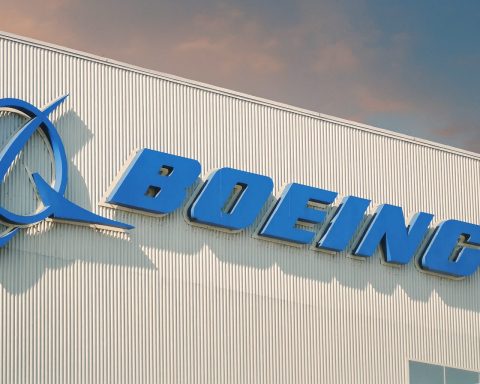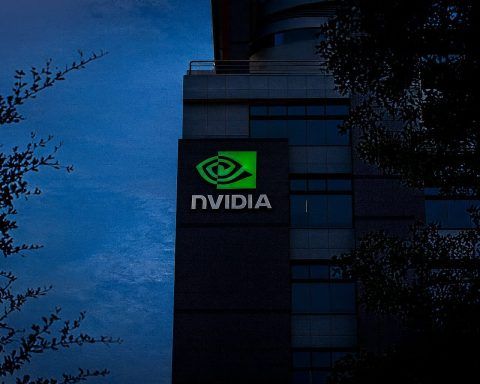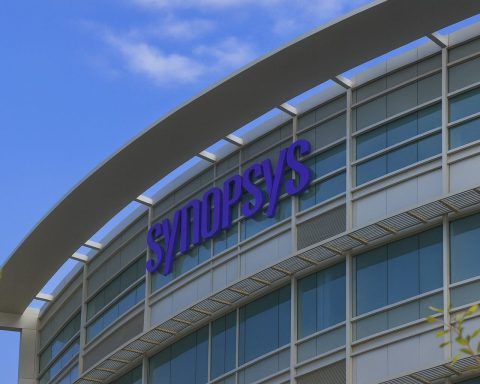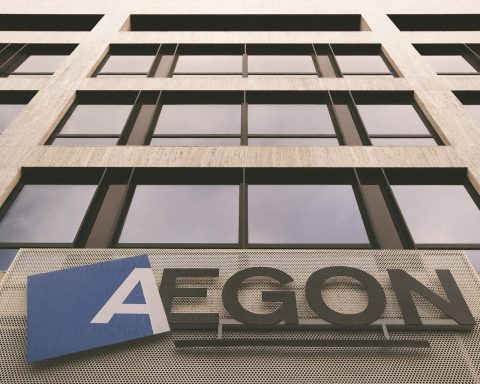- Nvidia’s rally hits a wall: AI-chip leader Nvidia delivered booming sales and an upbeat outlook, yet its stock fell ~4% over Aug. 28–29 as results only met sky-high expectations and China uncertainties weighed [1]. CEO Jensen Huang insisted “a new industrial revolution has started… the AI race is on,” projecting a $3–4 trillion AI market by 2030 [2].
- Dell’s AI boom vs. profit squeeze:Dell Technologies reported a surge in AI server orders (>$20 billion worth, from clients like Elon Musk’s xAI and CoreWeave) and raised its revenue forecast [3]. Yet Dell’s stock plunged ~9–10% on Aug. 29 after warning that high costs and fierce competition are eroding profit margins on these AI deals [4].
- Chipmaker fortunes diverge:Marvell Technology – an “AI picks-and-shovels” chip supplier – crashed 18–19% in one day after issuing weaker-than-expected guidance despite the AI chip boom [5]. In contrast, rival Broadcom only slipped ~3% alongside Nvidia [6]. A broad semiconductor selloff dragged the PHLX Semiconductor Index down ~3% on Aug. 29 [7].
- Alibaba ignites Asia’s AI surge: Chinese tech giant Alibaba saw its U.S.-listed shares skyrocket 13% on Aug. 29 after a surprise 26% jump in cloud revenue – fueled by AI demand – and unveiling its own cutting-edge AI chip for data centers [8]. Alibaba’s stock was one of Wall Street’s most-traded that day [9], underscoring how aggressively Asian firms are investing in homegrown AI silicon.
- AI darlings temper gains:Palantir – 2025’s top S&P 500 performer – dipped ~0.9% on Aug. 29 amid the tech sell-off [10]. The stock had doubled this year on AI-fueled demand [11] [12], but now faces valuation scrutiny at 200× earnings, the priciest in the index [13]. Similarly, enterprise AI firm C3.ai saw its shares slide ~2% on Friday and remain far below 2023 highs [14], reflecting investor caution toward unprofitable AI plays.
- Hot AI stocks hit hurdles: High-flyer Super Micro Computer – which makes AI servers – sank ~5% after disclosing “material weaknesses” in its financial controls that could delay reporting [15]. Over $1 billion in value was wiped out, a reality check for one of 2023’s hottest AI hardware stocks [16].
- Big deals and AI arms race: Established tech players are pouring cash into AI startups. Cybersecurity firm CrowdStrike announced a $290 million acquisition of AI analytics startup Onum to “stop breaches at the speed of AI,” as firms race to build AI capabilities [17]. CEO George Kurtz said more data and AI give a “larger moat” against cyber threats [18].
- Global regulators weigh in: Geopolitics is casting a cloud over AI. Nvidia excluded all future China sales from its forecast amid murky U.S. export curbs [19]. Washington struck a deal to license Nvidia’s China chip exports in exchange for a government cut of sales [20], but uncertainty persists. In Europe, officials rebuffed industry calls to delay the EU’s landmark AI Act, saying “there is no stop-the-clock… no pause” as new AI rules begin phasing in [21]. Canada and others are likewise eyeing stricter AI oversight, signaling a global push to rein in AI risks [22].
Wall Street’s AI Rally Hits a Speed Bump
After months of euphoria, U.S. equity markets stumbled into the weekend, led by a pullback in AI-focused stocks. On Friday, Aug. 29, the Nasdaq Composite sank about 1.2% and the S&P 500 fell 0.6%, snapping a streak of gains as traders locked in profits on this year’s AI-fueled winners [23] [24]. The sell-off was broad-based: Nvidia slid 3.4% Friday (its third down day in a row), Tesla and Broadcom dropped over 3%, and even mega-caps like Meta, Amazon, Microsoft, and Alphabet gave back 1–2% [25]. High-flying tech names had risen to records on AI optimism, so investors seized the chance to take profits, citing jitters that the “AI trade” may have run ahead of itself.
Several AI-leveraged stocks saw especially sharp reversals. Enterprise software giant Oracle, which has touted major AI initiatives, tumbled nearly 6% on Aug. 29 [26]. Super Micro Computer (SMCI) – a pure-play maker of AI servers – plunged 5.5% Friday [27]. Notably, both stocks had surged earlier in the week after Nvidia’s earnings, before abruptly reversing course. “The rally lost steam,” one analyst observed, as enthusiasm cooled heading into the weekend [28]. “Today is just weakness in the top of the market, in tech… This is not the first time we’ve had worries about over-investment in AI and lack of monetization,” noted Zachary Hill of Horizon Investments, pointing to recurring concerns that AI hype might be outpacing tangible returns [29]. In short, sentiment shifted from FOMO to caution in a matter of days.
Despite this late-week dip, August remained a banner month for equities thanks to AI. All three major U.S. indices still notched their fourth straight monthly gain, fueled in large part by AI optimism [30]. The Nasdaq rose ~1.6% in August, and the S&P 500 gained ~1.9%, buoyed by bets that surging demand for artificial intelligence will boost revenues across chips, software, and cloud services [31]. AI-centric stocks and funds far outpaced the broader market – for example, Morningstar’s Global Artificial Intelligence Index was up 26.7% year-to-date by mid-August, ~16 percentage points ahead of the market. This huge outperformance shows how central the “AI trade” has become in 2025. But it also raises the stakes: any hint of slowing AI growth or signs of an AI bubble can now spur rapid volatility, as evidenced by late August’s profit-taking wave.
Nvidia’s Blockbuster Quarter Meets High Expectations
Nvidia, the poster child of the AI boom, reported another quarter of jaw-dropping growth – but even “spectacular” results weren’t enough to push its stock higher. On Aug. 28, Nvidia announced fiscal Q2 earnings that shattered year-ago numbers, fueled by insatiable demand for its AI chips (the powerful GPUs behind services like ChatGPT) [32]. Data-center chip revenue exploded, and Nvidia issued an upbeat forecast for next quarter, projecting $54 billion in Q3 revenue (above the ~$53 billion consensus) [33] [34]. CEO Jensen Huang dismissed talk of an AI slowdown, asserting that opportunities will “expand into a multi-trillion-dollar market” and calling this the start of a new industrial revolution [35] [36]. Indeed, Nvidia’s CFO noted the company expects its government and enterprise “sovereign AI” initiatives alone to drive $20 billion in sales this year, and foresaw $600 billion in global AI spending by businesses in 2025 – on the way to $3–4 trillion by 2030 [37] [38].
Yet Nvidia’s stock fell ~2% on Aug. 28 (and extended losses to end the week down ~4% from its pre-earnings high [39]). The ostensibly good news had already been priced in by investors after Nvidia’s meteoric 2025 rise. In fact, some analysts were underwhelmed that the results, while strong, were “not a massive beat” above lofty expectations [40]. A key factor was China: Nvidia surprised markets by excluding all future China sales from its guidance due to U.S. export restrictions and geopolitical uncertainty [41]. The Biden (formerly Trump) administration’s curbs on advanced chip exports – and negotiations tying export licenses to a cut of Nvidia’s China revenue – have made it “impossible to forecast” that business [42] [43]. “Nvidia’s biggest bottleneck isn’t silicon, it’s diplomacy,” quipped Michael Ashley Schulman of Running Point Capital [44] [45]. By guiding conservatively and omitting China, Nvidia likely set a lower bar for future upside, but it also introduced doubt about how much trade tensions could cap its boom. CEO Huang estimated the China AI market could be $50 billion per year if policies allowed full access [46] [47] – a massive opportunity currently in limbo.
Analysts are divided on what Nvidia’s post-earnings dip means. Some see it as healthy consolidation: “The stock likely ran too far, too fast… I’d buy these shares if and when they settle,” said Paul Meeks of Freedom Capital, arguing Nvidia’s fundamentals remain stellar even if the hype needs to cool [48]. Indeed, Nvidia’s latest quarterly net income surpassed Apple’s, an unimaginable feat until this AI era [49]. Others caution that competition is rising and even Nvidia’s growth could eventually normalize. But so far, no true rival is denting its dominance. “Despite plenty of would-be rivals, Nvidia’s dominance remains clear in a white-hot AI market,” noted Tim Tully of Menlo Ventures, expecting next-gen Nvidia chips to drive “another wave of growth” as AI models demand ever more horsepower [50]. Investors also remain mindful of valuation – Nvidia’s stock has more than tripled this year, so at ~110x earnings it leaves little room for disappointment [51] [52]. That high bar explains the mild post-earnings pullback, which was actually Nvidia’s smallest reaction to an earnings beat since the AI frenzy began [53] [54]. In short, Nvidia proved AI demand is still red-hot and far from “over” – but it must navigate geopolitical headwinds and sky-high expectations on Wall Street.
Notably, other chipmakers moved in Nvidia’s wake. AMD shares fell ~1–2% after Nvidia’s report [55], as investors assessed how firmly Nvidia has cemented its lead in AI processors. Broadcom (AVGO), which also supplies AI-related chips, drifted ~3% lower into the weekend [56]. Meanwhile, lesser-known Marvell Technology (MRVL) became a cautionary tale (see below), plunging nearly 20% when its own outlook failed to impress despite the broader AI boom [57]. The message from late August: in the “picks and shovels” race for AI gold, even suppliers need to deliver spectacular results to justify their lofty stock runs.
Dell and Marvell: Booming AI Demand, Harsh Reality Check
Outside of the pure-play chip giants, the AI boom is reverberating across hardware makers – with mixed results. Dell Technologies, a stalwart in PCs and servers, surprised the market with how quickly it capitalized on AI. On Aug. 28, Dell blew past earnings estimates and hiked its full-year revenue forecast to ~$109 billion (up from $101–105B) thanks to red-hot demand for its new AI-optimized servers [58] [59]. Executives said orders for high-end AI servers are so strong, Dell expects to ship $20 billion worth of them in just the coming year [60] [61]. Major cloud providers and AI startups – including notable customers like CoreWeave and even Elon Musk’s fledgling xAI – are lining up for Dell’s hardware [62] [63]. In effect, Dell has swiftly become a key supplier of the expensive server rigs needed to train and run large AI models.
Investors initially cheered Dell’s AI-fueled sales beat. But that excitement flipped to concern once they looked under the hood at Dell’s profits. To secure these big AI deals, Dell raced to fill orders even if it meant higher production costs and cut-throat pricing. The result: Dell’s gross profit margins sank to 18.7%, missing estimates, as supply-chain expedite fees and discounted pricing ate into earnings [64] [65]. Dell admitted it chose to “prioritize fulfilling AI server orders over maintaining margins,” effectively sacrificing short-term profit to grab strategic AI business [66]. This trade-off spooked the Street – on Aug. 29, Dell’s stock plunged about 9–10%, the worst one-day drop in the S&P 500 [67] [68]. J.P. Morgan analysts noted Dell accepted a near-term profit squeeze to establish itself in AI, but investors worried “AI sales ‘boom’ might not translate to a boom in profits” [69] [70]. There’s also intensifying competition: rivals like Hewlett Packard Enterprise (HPE) are gunning for the same AI server market [71]. In short, while AI demand is giving Dell a huge revenue lift, the benefits to its bottom line are less clear, injecting volatility into what’s normally a steady value stock [72].
For Marvell Technology, a chipmaker supplying data-center and networking silicon, the story was even more sobering. Marvell had been touted as an “AI winner” riding Nvidia’s coattails – its chips help connect and optimize AI systems, so expectations were high. But on Aug. 29, Marvell revealed guidance that underwhelmed the market, and its stock cratered 18–19% in one session [73] [74]. This wipeout (Marvell’s worst drop in years) led the Nasdaq-100 losers and epitomized a “show me the money” attitude setting in toward secondary AI plays [75] [76]. Investors punished Marvell for not delivering the kind of dramatic upside that Nvidia had – a reminder that not every company tied to the AI trend will reap equal rewards. Marvell’s plunge wiped out roughly $10 billion in market cap and shocked analysts, given the company is still growing. The issue was simply lofty expectations: after Nvidia’s blowout quarter, Marvell’s merely decent outlook wasn’t enough. This sent a clear signal: the market is starting to differentiate winners from wannabes in the AI space. As one analyst put it, enthusiasm is shifting to “show me actual results” for those riding the AI wave [77]. Marvell’s stumble, alongside Dell’s margin squeeze, shows that even amidst historic AI demand, investors are getting more selective – rewarding those who execute flawlessly, and swiftly punishing those who fall short.
Chinese Tech Joins the AI Party: Alibaba’s Breakout
On the other side of the world, Asian tech giants are riding their own AI wave, with China’s Alibaba delivering the biggest headline of the week. Often dubbed the “Amazon of China,” Alibaba stunned markets by unveiling major strides in AI – and was richly rewarded by investors. On Aug. 29, Alibaba reported quarterly earnings that included a 26% surge in cloud computing revenue, far above expectations [78] [79]. Executives credited artificial intelligence workloads for the boom, as businesses flock to Alibaba’s cloud to run AI applications [80] [81]. In fact, Alibaba’s chief executive highlighted that “investments in AI have begun to yield tangible results,” with a clear path for AI to drive the company’s growth [82]. To underscore its AI ambitions, Alibaba also revealed it has developed a cutting-edge AI chip in-house – a more versatile new processor designed for a broad range of AI inference tasks [83]. This homegrown chip (reported by WSJ and confirmed by Reuters) is manufactured in China, sidestepping reliance on U.S. suppliers [84] [85]. It’s likely meant to fill the void left by Nvidia’s restricted chips, as U.S. export bans bite. Alibaba has poured over ¥100 billion (>$14B) into AI R&D in the past year [86] [87], racing to reduce dependence on foreign tech.
The market reaction was emphatic. Alibaba’s U.S.-listed shares soared 13% in a single day [88], their biggest jump in years, as global investors rushed to reprice Alibaba as an emerging AI leader. The stock was one of the most heavily traded on Wall Street Friday [89]. The enthusiasm reflects a view that Alibaba’s AI initiatives – from cloud services to chips – could unlock new growth and help it compete with Western peers in the AI arena. It also showcased how AI news can outweigh other concerns: notably, Alibaba’s overall revenue actually missed analysts’ estimates due to softer e-commerce results [90] [91]. But the AI-fueled cloud beat and chip reveal stole the spotlight. “Our investments in AI have begun to yield tangible results,” Alibaba’s team declared, and investors clearly agreed [92].
Alibaba’s surge highlights a broader trend: China’s tech titans are going all-in on AI, both to drive growth and to bolster technological self-sufficiency amid U.S. trade curbs. Other Chinese giants like Baidu, Tencent, and Huawei are likewise pouring resources into AI – from Baidu’s work on generative AI models to Huawei’s development of AI chips – especially as access to top-tier Nvidia GPUs is limited by sanctions [93] [94]. In Alibaba’s case, its new AI chip (first reported by Wall Street Journal) could power everything from e-commerce recommendations to cloud analytics [95] [96]. The fact that Alibaba pulled off a double-digit stock jump on these AI announcements shows that, at least for now, the market is rewarding tangible AI progress – East or West. It’s a stark contrast: while U.S. investors punished some AI “hype” stocks that didn’t deliver instant results (like Marvell), they piled into Alibaba for demonstrating real AI tech development and revenue traction. This East-West AI race is clearly heating up on the stock front.
AI Pure-Plays and Smaller Caps: Hype Meets Skepticism
Amid the giants, a cadre of “pure-play” AI companies and smaller-cap firms have been on a rollercoaster as well. Many of these names saw extraordinary gains earlier in 2025, only to face turbulence as investors reassess the sustainability of their runs.
Take Palantir Technologies, for example. The data analytics firm has aggressively refashioned itself as an AI leader, launching an “Artificial Intelligence Platform (AIP)” and securing big government AI contracts. Palantir’s narrative caught fire – its stock doubled in 2025 and at one point was up over 140% from spring lows [97], making it the top-performing S&P 500 stock through mid-August [98] [99]. In early August, Palantir even raised its revenue forecast for the second time this year, citing “soaring” demand for its AI services, which sent shares up nearly 9% in one day [100]. Bulls like Wedbush have talked up Palantir as a potential trillion-dollar company in coming years thanks to AI [101] [102]. But with such euphoria comes valuation concerns. By late August, Palantir traded at over 200× forward earnings, by far the richest valuation in the index (even above Nvidia at ~35×) [103] [104]. This has drawn skeptics – including noted short-sellers – who argue the stock is “priced for perfection.” Indeed, in the past weeks some analysts warned Palantir’s rally was overextended, and one high-profile short seller predicted a major pullback [105] [106]. That pessimism contributed to volatility: after hitting a record high around mid-August, Palantir’s stock slid roughly 7% over the next two weeks [107]. By Aug. 29, amid the broader tech downdraft, Palantir shares closed 0.89% lower for the day [108] [109] – a modest dip, but notable given the heavy trading volume (over $7 billion worth, seventh highest on U.S. markets) as investors debated its future [110] [111]. The bottom line: Palantir remains a poster-child of the AI stock boom, but it’s now straddling a fine line between delivering on AI promises and living up to a lofty valuation.
Another case is C3.ai (NYSE: AI), one of the few pure-play AI software companies public in the U.S. C3.ai became a retail trader favorite (with its aptly named ticker “AI”) during the hype earlier this year, at one point more than doubling. However, the company – which provides AI software platforms for enterprises – has consistently reported large losses, testing investors’ patience. After peaking above $30 in early 2023, C3.ai’s stock has slid about 50% to the mid-teens [112] [113]. On Aug. 29, C3.ai shares fell ~2.3% to around $16.90 [114]. There wasn’t specific news driving the drop; rather, it’s part of a broader cooling toward unprofitable “story stocks.” With earnings coming up in early September, the market seems to be saying: “show us real growth or AI traction.” Similarly, other small-cap AI names like BigBear.ai (BBAI) and SoundHound AI (SOUN), which saw speculative surges in the first half, have given back gains. The overarching theme is that investors are rotating toward quality – rewarding companies that can demonstrate tangible AI revenue or unique tech, while pulling back from those that rode the hype but have yet to prove a profitable model.
Even former market darlings aren’t immune to scrutiny. Super Micro Computer (SMCI) is one such example. SMCI rode the AI wave by selling specialized servers to handle AI workloads, and its stock rocketed ~300% in 2023. But on Aug. 29, SMCI disclosed some accounting and control issues – specifically, “material weaknesses” in financial reporting controls and prior auditor resignations [115]. Although these issues don’t directly relate to AI, they rattled confidence. SMCI’s stock plunged ~5.5% Friday and is down significantly from its highs [116], erasing over $1 billion in market cap in one day [117]. It was a stark reminder that fundamentals and good governance still matter, even for a hot AI play.
In summary, the smaller-cap and pure-play AI stocks are experiencing a reality check. The group’s dramatic run-ups have met rising skepticism from Wall Street. Financial commentators note that we’re entering a phase where the “AI gold rush” needs to translate into real gold – i.e. revenue growth, earnings, or at least clear product traction. Those that can deliver (like Palantir showing real sales to governments, or SMCI selling actual hardware) still have support, albeit volatile. Those that falter, even briefly (like C3.ai with slowing growth, or SMCI with internal issues), are getting swiftly penalized. The hype around “all things AI” is evolving into a more nuanced view: investors are starting to separate the winners from the also-rans.
Global AI Developments: Regulation and Deals
Regulators worldwide are increasingly stepping into the AI arena, a development that could shape the long-term trajectory of AI stocks. In Washington, the U.S.–China tech standoff remains a big overhang. The U.S. government’s export restrictions on advanced AI chips have already forced Nvidia to create cut-down China-only products (like the H20 GPU), and even those have faced further curbs [118] [119]. Recently, President Trump (now in office) struck a tentative deal granting Nvidia some export licenses in exchange for the U.S. government taking a fee on China sales [120] [121]. This unprecedented arrangement effectively makes Washington a stakeholder in Nvidia’s China business, and highlights how geopolitical tensions are intertwining with corporate strategy. Still, with no formal rules finalized, Nvidia had to assume zero China revenue going forward in its latest guidance [122] – a stark sign of how policy risk is clouding even the brightest AI star. Analysts warn that continued U.S.–China tensions could spur Chinese companies (like Alibaba, Huawei) to double down on indigenous AI chips, potentially shifting the competitive landscape [123] [124].
Across the Atlantic, Europe is forging ahead with AI regulation. EU officials made headlines by refusing to delay the EU AI Act, a sweeping law that will govern AI use, despite tech industry lobbying [125]. “There is no stop the clock… no pause,” an EU spokesperson declared, confirming that new rules for AI systems began phasing in this August [126]. The AI Act imposes strict requirements on “high-risk” AI applications (like in healthcare or finance) and greater transparency for general AI models, among other provisions. This could increase compliance costs for AI developers but also create clearer standards that might favor well-resourced players. Meanwhile, Canada is crafting its own Artificial Intelligence and Data Act, after a poll showed 85% of Canadians favor regulating AI [127]. And the U.K. is convening a global AI Safety Summit in the fall [128], aiming to establish international guidelines for AI development and use. For investors, these regulatory moves are a double-edged sword: in the long run they may mitigate societal risks (thus ensuring AI’s sustainable growth), but in the near term they could raise costs or uncertainty for companies depending on how strict and wide-reaching the rules become. AI-focused firms are already beefing up compliance teams and engaging with policymakers, knowing that regulation is coming in 2025 and beyond.
On the corporate front, AI-driven dealmaking is in full swing. Established tech companies flush with cash are in an arms race to acquire AI startups and talent. One notable deal this period was CrowdStrike’s $290 million purchase of Onum, a startup specializing in AI-driven data analytics for cybersecurity [129]. CrowdStrike (a leader in cyber defense) said it wants to “stop breaches at the speed of AI,” indicating it will integrate Onum’s AI tech to make its threat detection more autonomous [130]. CEO George Kurtz commented that the more data and AI his firm can leverage, “the larger the moat… from an AI perspective,” highlighting how scale and data are key competitive moats in the AI era [131]. This is just one example – in recent weeks, IBM, Salesforce, and others have also announced smaller AI-related acquisitions or investments. Venture capital funding in AI startups remains red-hot as well, though IPO activity has been sparse (many are staying private for now). The broader point is that major players are investing aggressively in AI capabilities, whether via R&D or M&A, which ultimately reinforces why AI remains a central market theme. Every big bank, cloud provider, and enterprise software firm is touting their AI strategy, and backing it up with dollars. From an investor standpoint, this wave of investment could lead to consolidation (as larger companies absorb promising AI upstarts) and will likely separate winners from losers: those who fail to invest in AI risk falling behind, while those who do are betting it will pay off in increased productivity, new products, or cost savings.
Expert Commentary: Bubble Concerns vs. Long-Term Optimism
With AI dominating market narratives in 2025, it’s no surprise that opinions on this “AI stock frenzy” are plentiful. Some experts have started sounding bubble warnings. Notably, OpenAI CEO Sam Altman (one of the pioneers of the AI boom) remarked recently that “some investors are likely to lose a lot of money” in AI and that there will be periods of “irrational exuberance”, even if the technology’s long-term value is immense [132] [133]. A study out of MIT made waves by reporting 95% of companies adopting generative AI are seeing “zero return” so far [134] [135] – implying that the business payoff of AI at scale may take longer than stock prices imply. High-profile analysts have drawn parallels to past tech manias, urging caution that the AI boom could be pricing in perfection. For example, a Reuters “Market Talk” column on Aug. 28 quoted one CIO as saying they “urge caution with Nvidia’s stock through year end,” given its huge run-up [136]. And short-seller firms have openly targeted names like Palantir and C3.ai, calling them overhyped relative to current earnings.
At the same time, many market strategists remain bullish that we are only in the early innings of the AI revolution. The consensus among optimists is that AI is a fundamental transformative force – akin to the advent of the internet or mobile – and thus will drive years of investment and growth. Nvidia’s Jensen Huang has repeatedly said we’re seeing the start of a “new industrial revolution” with AI [137]. Companies themselves are reinforcing this outlook: nearly every big tech CEO from Microsoft’s Satya Nadella to Google’s Sundar Pichai has stressed that AI is now central to their strategy (e.g. Google just announced it will replace its Assistant with a next-gen “Gemini” AI model in consumer devices [138]). Wall Street’s AI bulls argue that while valuations are high, the potential productivity boost and new revenue streams from AI justify a premium. As evidence, they point to surging capex on AI infrastructure – cloud giants are spending billions on AI data centers – and to early wins like Palantir’s big government contracts or Salesforce’s AI-driven uptick as signs that real money is being made. Even with some stocks pulling back, funds continue to flow into the sector; for instance, AI-focused ETFs have seen strong inflows throughout the summer.
In short, the market is grappling with a balance between short-term hype and long-term promise. The late-August news encapsulated this tension: record-smashing results and exuberance (Nvidia, Alibaba) on one hand, and first signs of caution (profit-taking, Marvell’s flop, talk of bubbles) on the other. As August 30–31 wrapped up, the AI stock trade appears to be entering a new phase – one demanding discrimination and discernment. Investors and analysts are no longer buying anything with “AI” in the story unquestioningly; they are looking for concrete progress, competitive moats, and reasonable pricing. The period’s events – from Nvidia’s tempered rally to Alibaba’s explosive jump, from Dell’s margin lesson to Palantir’s fickle swings – all reinforce a key takeaway: AI remains the driving narrative of global markets, but as summer turns to fall, both companies and investors are learning that sustaining the “AI stock boom” will require navigating reality checks even as the broader revolution marches on [139] [140].
References
1. ts2.tech, 2. ts2.tech, 3. ts2.tech, 4. ts2.tech, 5. ts2.tech, 6. ts2.tech, 7. ts2.tech, 8. ts2.tech, 9. ts2.tech, 10. www.ainvest.com, 11. www.reuters.com, 12. www.reuters.com, 13. www.reuters.com, 14. intellectia.ai, 15. ts2.tech, 16. ts2.tech, 17. ts2.tech, 18. ts2.tech, 19. ts2.tech, 20. ts2.tech, 21. ts2.tech, 22. ts2.tech, 23. ts2.tech, 24. ts2.tech, 25. ts2.tech, 26. ts2.tech, 27. ts2.tech, 28. ts2.tech, 29. ts2.tech, 30. ts2.tech, 31. ts2.tech, 32. ts2.tech, 33. www.reuters.com, 34. www.reuters.com, 35. ts2.tech, 36. ts2.tech, 37. www.reuters.com, 38. www.reuters.com, 39. ts2.tech, 40. ts2.tech, 41. ts2.tech, 42. ts2.tech, 43. ts2.tech, 44. www.reuters.com, 45. www.reuters.com, 46. ts2.tech, 47. ts2.tech, 48. ts2.tech, 49. ts2.tech, 50. ts2.tech, 51. www.reuters.com, 52. www.reuters.com, 53. www.reuters.com, 54. www.reuters.com, 55. www.reuters.com, 56. ts2.tech, 57. ts2.tech, 58. ts2.tech, 59. ts2.tech, 60. ts2.tech, 61. ts2.tech, 62. ts2.tech, 63. ts2.tech, 64. ts2.tech, 65. ts2.tech, 66. ts2.tech, 67. ts2.tech, 68. ts2.tech, 69. ts2.tech, 70. ts2.tech, 71. ts2.tech, 72. ts2.tech, 73. ts2.tech, 74. ts2.tech, 75. ts2.tech, 76. ts2.tech, 77. ts2.tech, 78. www.reuters.com, 79. www.reuters.com, 80. www.reuters.com, 81. www.reuters.com, 82. www.reuters.com, 83. www.reuters.com, 84. www.reuters.com, 85. www.reuters.com, 86. www.reuters.com, 87. www.reuters.com, 88. ts2.tech, 89. ts2.tech, 90. www.reuters.com, 91. www.reuters.com, 92. www.reuters.com, 93. ts2.tech, 94. ts2.tech, 95. ts2.tech, 96. ts2.tech, 97. www.ainvest.com, 98. www.reuters.com, 99. www.reuters.com, 100. www.reuters.com, 101. www.reuters.com, 102. www.reuters.com, 103. www.reuters.com, 104. www.reuters.com, 105. www.morningstar.com, 106. www.investopedia.com, 107. www.morningstar.com, 108. www.ainvest.com, 109. www.ainvest.com, 110. www.ainvest.com, 111. www.ainvest.com, 112. www.fool.com, 113. intellectia.ai, 114. intellectia.ai, 115. ts2.tech, 116. ts2.tech, 117. ts2.tech, 118. www.reuters.com, 119. www.reuters.com, 120. www.reuters.com, 121. www.reuters.com, 122. ts2.tech, 123. www.reuters.com, 124. www.reuters.com, 125. ts2.tech, 126. ts2.tech, 127. ts2.tech, 128. ts2.tech, 129. ts2.tech, 130. ts2.tech, 131. ts2.tech, 132. www.pymnts.com, 133. www.pymnts.com, 134. www.pymnts.com, 135. www.pymnts.com, 136. www.reuters.com, 137. ts2.tech, 138. www.pymnts.com, 139. ts2.tech, 140. ts2.tech










